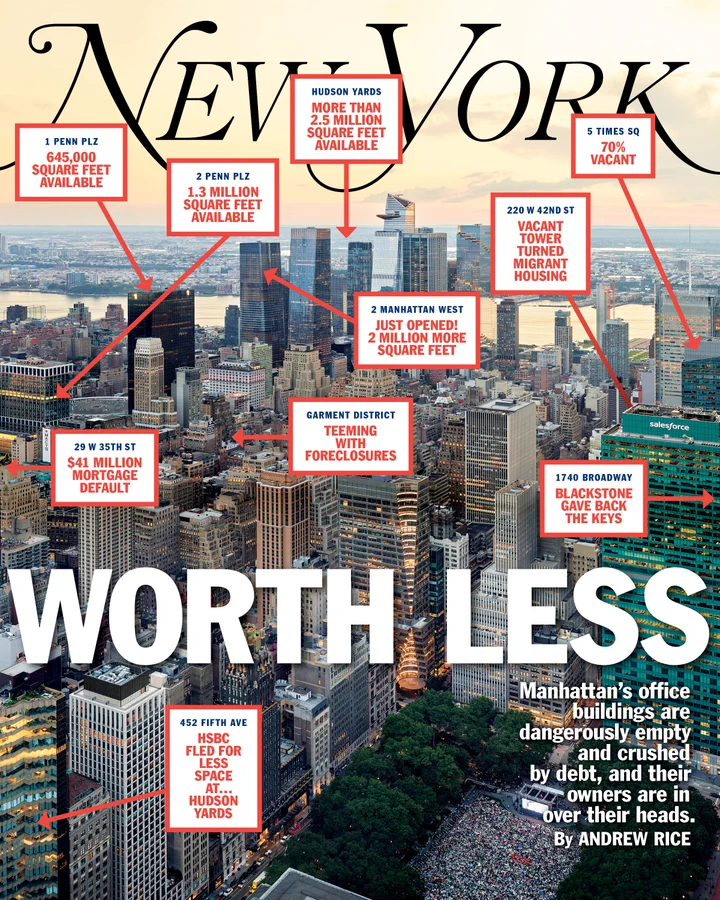2H 2023 in Commercial Real Estate, Part Two: Office-Retail-Industrial-R&D
In Part One, we reviewed the 2023 outlook for commercial real estate in housing (i.e., apartment buildings rather than single-family residential). In Part Two, we show that top-tier/best-in-class U.S. office, R&D, industrial, and retail sectors are also expected to perform well in the second half of 2023 despite economic headwinds and ongoing capital market disruptions.
Contents
Non-Housing Commercial Real Estate
Quick Facts on the Market
Office
The office market, largely due to Covid remnants and behavior changes in employment, remains an outlier and underperforming segment, currently or for the near future.
Reduced demand, rising vacancy and declining rents are the bellwethers of the US Office market in 2H 2023. Hybrid work and office utilization are among the salient barriers. Repurposing of office buildings into multi-family, mixed use or industrial is intriguing in many areas, but there are a number of challenges.
- The slow and uneven recovery of the US office market in the aftermath of the pandemic has created a deep divide between prime and secondary office buildings that is expected to continue to widen during 2H 2023. Demand for the best buildings in attractive locations will support rent growth in top-tier office towers. By contrast, there will be a smaller pool of tenants interested in older office buildings.
- One reason for the differential between top tier and older building utilization is that newer buildings tend to have amenities that are attractive to office workers, and which are often missing in older buildings.
- Despite continued office-using employment growth, the US office market recorded 8.5 million sq. ft. of negative net absorption in Q2 2023 amid economic uncertainty and tepid office attendance rates.
- Negative net absorption and the completion of 8.3mm sq. ft. of new supply pushed the overall office vacancy rate up by 40 basis points (bps) quarter-over-quarter to 18.2% in Q2 2023.
- “The true severity of the office market’s struggles is being concealed by vacancy rates that only tell half the story. Behind all the empty buildings are offices that are wildly unoccupied due to the prevalence of remote and hybrid schedules compounded with rising costs and inflation. Businesses simply do not need as large a footprint demanded in the past and are occupying their leases not at optimum capacity until their expiration ends and they can find a location that suits their new streamlined footprint.”
- In Q2 2023, average asking rent for US office increased only 0.5% year-over-year to $35.45 SF. Tenant-favorable market conditions persisted as the average taking rent increased by just 0.3% year-over-year and fell slightly from Q1.
- Buildings constructed since 2010 recorded positive net absorption in Q2 and had an overall vacancy rate of 14.4%, which was 3.8% lower than the rate for all buildings.
- Less affected regions will include the Sun Belt – e.g., Austin, Dallas, Miami and Nashville – these are expect to remain in favor. Best-in-class properties in otherwise hard-hit primary markets, including Manhattan and Los Angeles, will also garner more interest; provided that, longer commutes in those congested cities are a strong disincentive to workers.
Office Case Study: New York City
- In Q2 2023, Manhattan reached a decades long high availability rate of 19.9% – 15.4% direct availability and 4.5% sublease availability. The 103.3 million square feet (msf) of currently available space grew from 102.4 msf in Q1 2023.
- Through the first half of 2023, Manhattan has experienced 12.2 msf of leasing activity – 39.5% below the pre-COVID average and 29.8% below this time last year. While this activity is historically low, the previous low watermark in the last two decades was in 2009.
- Despite tepid leasing activity, the Manhattan office market continues to experience the “flight-to-quality” trend, where the top portion of office inventory significantly outperforms the rest of the market in leasing volume. Through the first half of 2023, Trophy and Class A properties (the top 25% of office inventory) represented 72.6% of leasing activity across Manhattan.
Repurposing Offices into Other CRE
The idea of redesigning office buildings as multifamily communities is getting the attention of a wide spectrum of stakeholders. In such markets as Dallas, Los Angeles, Washington, D.C., and New York City, the confluence of high demand for residential and struggling office properties has generated conversion projects. Vintage office buildings from the first half of the 20th century and later can offer landmark-caliber architecture.
However, there are a host of potential barriers, e.g.:
- The complex realities of design, construction and finance.
- Properties targeted for conversion will have to be in locations where rents are high enough to justify the cost of makeovers.
- The layout must be suitable for residential use, and the building’s infrastructure may not be a good fit due to, e.g., structural changes may be needed that will drive up costs, along with the expense of converting utility systems into household use.
Research & Development
- A [Q2 2022] report from CBRE indicates that the San Francisco Bay Area has the highest demand in the country for life science lab space. The 4.4 million square feet of demand is slightly more than Boston’s 4.2 million, with Bay Area average rents now standing at $67.72 sq ft/yr, well above the 12-market, life sciences hubs average of $54.77 sq ft/yr.
- In other regions, growing demand among life science tenants, who generally don’t allow remote work, will buoy R&D hubs like Denver and Salt Lake City.
CBRE forecasts that total life sciences lab/R&D space may increase by more than 20% over 2024-2025, as a record-high amount of new construction is currently underway. This likely will push the vacancy rate up moderately.
Industrial
- J.P. Morgan reports that the industrial sector may be stabilizing: “Fueled by e-commerce and an everything-on-demand economy, industrial has been booming for years. While the asset class remains healthy, it may be starting to soften. The vacancy rate for distribution and warehouse space was 4.1% throughout the second half of 2022—a record low, as the rate has steadily declined each quarter since the end of 2020. The rate rose 10 basis points in the first quarter of 2023 to 4.2%.”
- E-commerce growth, supply chain transformation, and location optimization will continue to drive demand for industrial space in 2023. Leading occupiers will focus on markets with strong population growth and modern distribution space to ensure quick delivery of online orders.
- Younger shoppers are driving this trend, which will prompt companies to increase their warehouse presence in markets with young and growing population demographics, including Salt Lake City, Las Vegas, and Phoenix.
Retail
- With new construction remaining cost-prohibitive, retail developers and investors will focus on redesigning and redeveloping existing space to attract more shoppers. This will be especially true in prime trade areas, which are experiencing record-high occupancy levels and asking rents due to strong demand. Some of this redevelopment activity will involve conversions to other uses, such as office, industrial, and residential.
Key Trends in Non-Housing Commercial Real Estate – A Prophetic View
Here are some factors expected to influence/impact US CRE in 2023:
Labor Pool
The struggle to hire will continue to contribute to rising project costs and overall delays in 2023.
Prop Tech
By centralizing operations, companies will have an increased ability to standardize tech processes and solutions across their organization. Bringing more processes within the corporate environment will allow companies to ensure that recommended and optimized systems are being used to complete the job requirements. Additionally, organizations should be able to strengthen their data integration between systems and even glean more information from it.
Artificial Intelligence (AI)
A logical next step will be to add an Artificial Intelligence and machine-learning component on top of the data being processed to help identify trends. The goal will be to not only use this data for descriptive analytics (data showing what’s already happened) and predictive analytics (data showing what’s going to happen) but to proactively provide prescriptive analytics, which is data that informs teams how to rectify future problems before they occur.
Supply Chain
Supply chain issues across water (sea cargo) and land continue to improve, giving the construction industry cause to be optimistic into 2023. However, certain construction materials remain difficult to source and the long lead times put additional strain on the industry.
Materials
With demand for certain sectors cooling off, many material prices continue to either stabilize or drop. While factors such as geopolitical instability, inflation, and gas prices are expected to continue to add strain to the supply chain, these obstacles are not impacting material costs to the extent that they were in early 2022.
Digital Commerce
The rise of e-commerce sales since the beginning of the pandemic has been a key catalyst for industrial growth and e-commerce sales are expected to surpass $1 trillion this year, highlighting the lingering demand for warehouse space.
Design
Architectural teams are currently facing unique obstacles caused by construction unemployment, supply chain issues, and material volatility. These teams are tasked with conceptual design, preliminary pricing, entitlements, construction documents, and construction administration through completion. Many of these crucial steps are experiencing long lead times caused by heavily booked due diligence consultants, ever-changing design expectations from municipality Design Review Boards, and increasing entitlement and permit review durations.
Sample Regional Outlook — The Southwest
Phoenix
- Phoenix is one of the hottest commercial real estate markets. With a current population of over 4.6 million, a 1.48% increase from 2021, the Phoenix metro is packed with abundant job growth, consumer spending, and investment opportunities.
- Throughout the U.S., Phoenix had the largest absolute increase in population growth between 2010 and 2020 and reported the fastest growth rate among America’s biggest cities (New York Times).
- The Greater Phoenix region, overall, is one of the strongest markets in the country for non-housing commercial real estate:
“Phoenix offers a diverse business economy with sectors including aerospace, technology, agriculture, tourism, and active semiconductor industry. Thanks in part to the largest foreign direct investment in the U.S. by the Taiwan Semiconductor Manufacturing Company’s (TSMC) facility in North Phoenix, the Valley is set to be the top semiconductor region in the country once TSMC is up and running.”
Research & Development
- Intel was the first big tech company that decided to bet on Phoenix, establishing a large office in Chandler twenty years ago. SanDisk followed soon after.
- The Covid-19 pandemic led to an influx of tech workers and companies from larger US tech hubs like San Francisco, ushering in a new growth phase for the Phoenix tech scene.
- By the end of 2020, 60,000 tech workers had relocated to Phoenix from California, following the lead of 45 tech companies that had also chosen the Valley of the Sun as their new home.
- According to CompTIA, one out of five workers based in Arizona are employed in Tech, which brings an estimated $25bn of annual revenues to the state. More than 100,000 people work in computer science occupations at Information and Communications Technology (“ICT”) companies. The ICT workforce in Phoenix has experienced a 64.1% job growth in the past decade, well above the national average of 34% in the same time period.
Industrial
- [Q1 2023] In the Phoenix metro area, 46 million sq ft of industrial construction is taking place, making Phoenix second only to Dallas (67 million sq ft) in current industrial production.
- Two main components can be attributed to Phoenix’s monumental industrial performance over the last two years, rent growth and low supply. With out-of-state investors flooding the Valley and delayed development timelines, buyers and tenants are being forced to pay premium pricing on industrial properties.
- As of August 2022, the asset class’s annual rent growth rate was 16.5%, much higher than the national average. Market sale price per square foot also accelerated, reaching $168, a 19% increase year-over-year.
- Demand for industrial & logistics warehousing space is driving an increase in mega warehouses. In 2022, Phoenix had four of the top 100 leases for a total of 6 million sq ft of industrial space, with two of the leases being traditional retailers/wholesalers. E-commerce had the largest square footage leased in the Valley at 1.2 million sq ft, and third-party logistics (3PL) secured 1.2 million sq ft in Glendale.
Retail
- The thriving local job economy combined with the market’s population growth has helped Phoenix’s retail sector quickly recover from the impact of COVID-19 and increase its popularity among investors. Leasing volume is substantial, with 4.4 million square feet absorbed within the last 12 months, according to CoStar. Smaller, niche tenants are performing well and rapidly growing. Boutique gyms such as F45 or popular local coffee providers like Dutch Bros and Black Rock Coffee are “storming” the Valley and offer investors a smaller retail footprint solution.
- Rents are steadily increasing and are above the national average, as Phoenix’s same-store asking rents increased 7.1% Y-o-Y while the US average increase is 4.3%.
- Investors are entering the market as new development and redevelopment projects pop up across the region, especially in growing submarkets. One of the largest retail redevelopments, PV, a mixed-use complex set to complete its first phase by 2024, is in North Phoenix and will offer a 400-unit multifamily building in addition to various retail fronts, hospitality, and entertainment venues. With growing opportunities and increased competition, pricing has increased, reaching an average of $250/yr sq ft.
Office
- [Q4 2022] Big vacancy stats (24.3%) in Q4 2022.
- Current asking rents average $28.62/yr sq ft.
Tucson
Office
- Office vacancy in 2022 averaged 10.4%.
- Trend predicted: Over the near term, a continuing return-to-office momentum will eventually bring about decreased office vacancies and increased rents.
Industrial
- The industrial market is experiencing historic high occupancies with a vacancy rate currently at 2.5%.
- New construction is scheduled to be delivered by the end of [2023], but in the meantime, there is considerable pressure to increase lease rates.
Retail
- [Q4 2022] Tucson retail vacancy rates held steady at 6.2% at year-end, while absorption rates were below normal.
- Significant restaurant activity continued across the spectrum, including dessert concepts, health foods, and other new entries to the Tucson food scene. “Med-tail” is also very actively going into spaces that were traditionally more retail oriented with concepts like injectables and medispas. Other categories of note include car wash, auto parts, and grocery.
- Hot submarkets with strong activity include southeastern Tucson in the Houghton area, the I-19 corridor from the I-10 junction south to Sahuarita, The Bridges near I-10 in south central Tucson, and Oro Valley.
- With build-to-suit activity dominating construction, investment speculators and cash buyers have been sidelined by the uncertain interest rate environment. While there are over 205,000 square feet under construction, 97% of it is pre-leased.
Further Information and Detail is Readily Available
When you’re ready for added advice, consultation, and assistance with your Commercial Real Estate plans for industrial/retail/R&D/office projects, feel free to contact us – we’re standing by to help.




